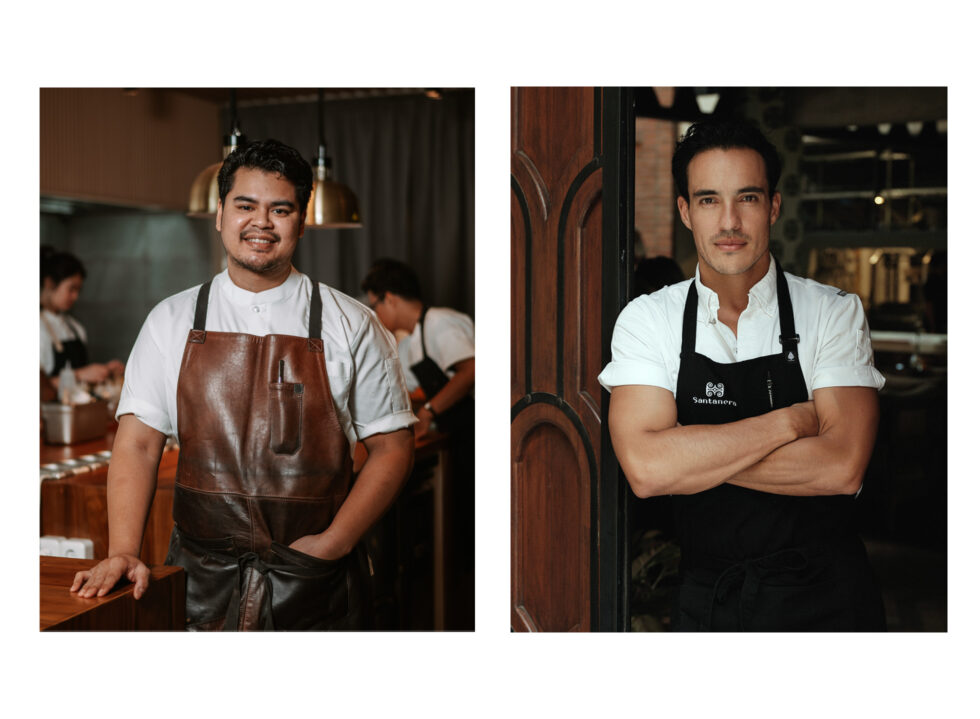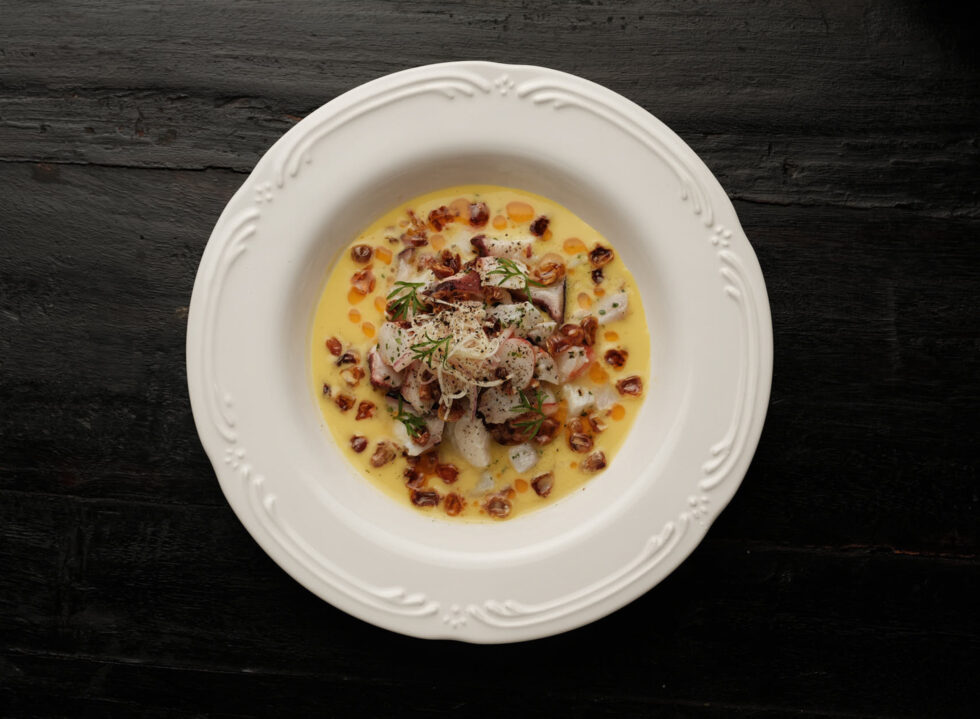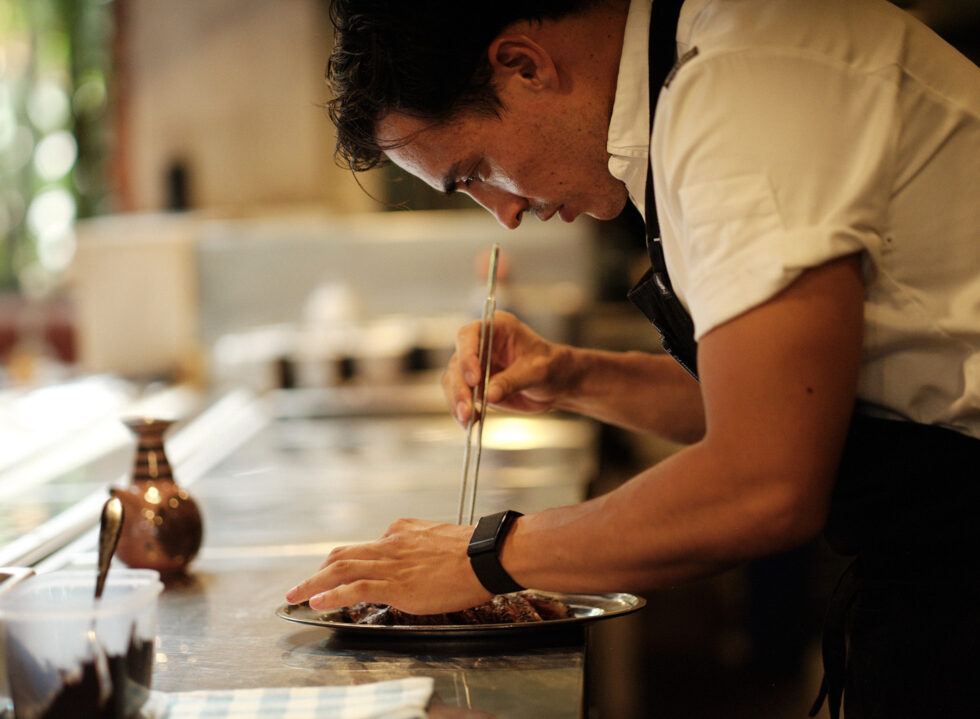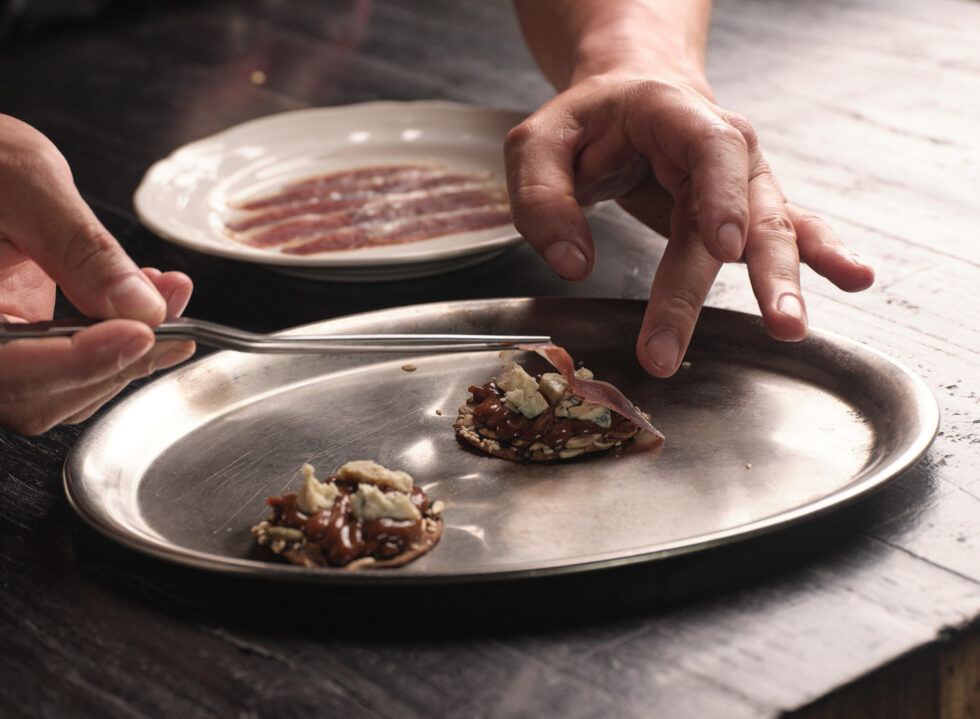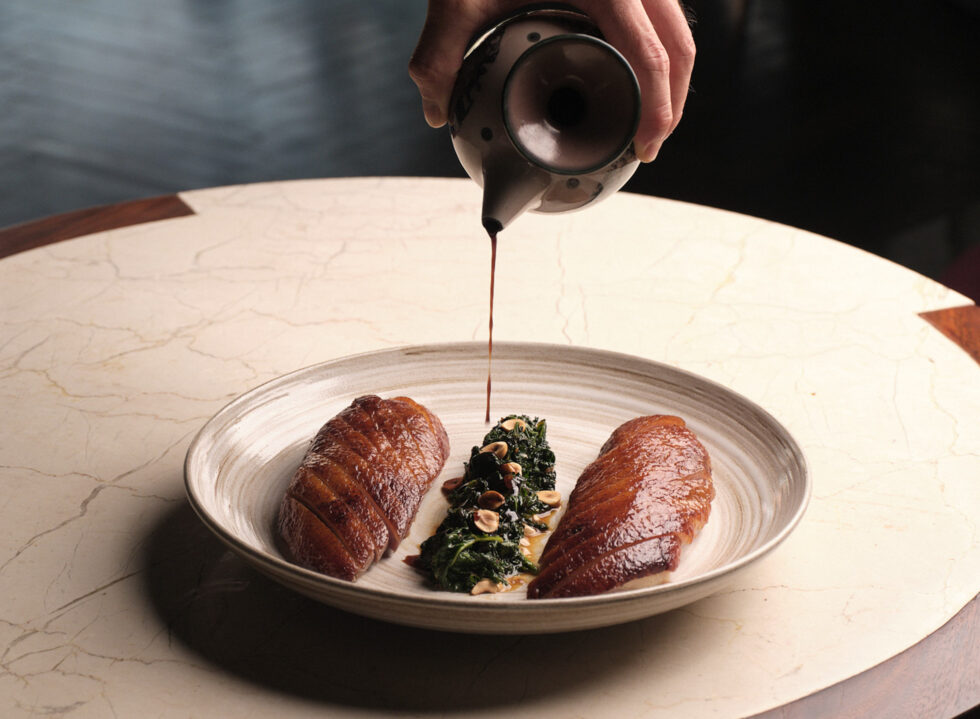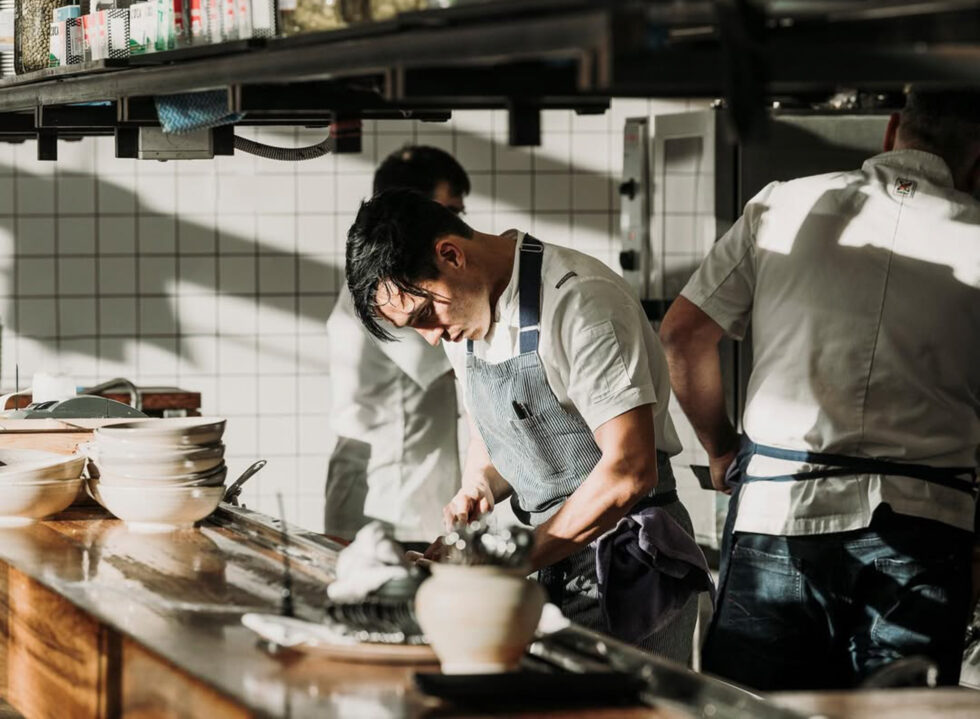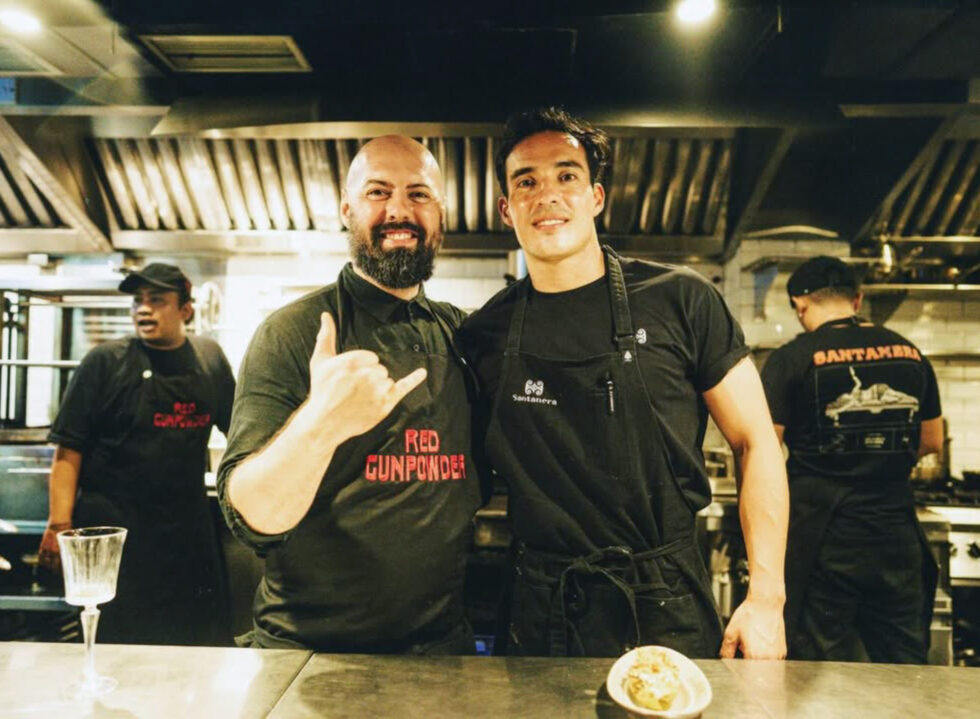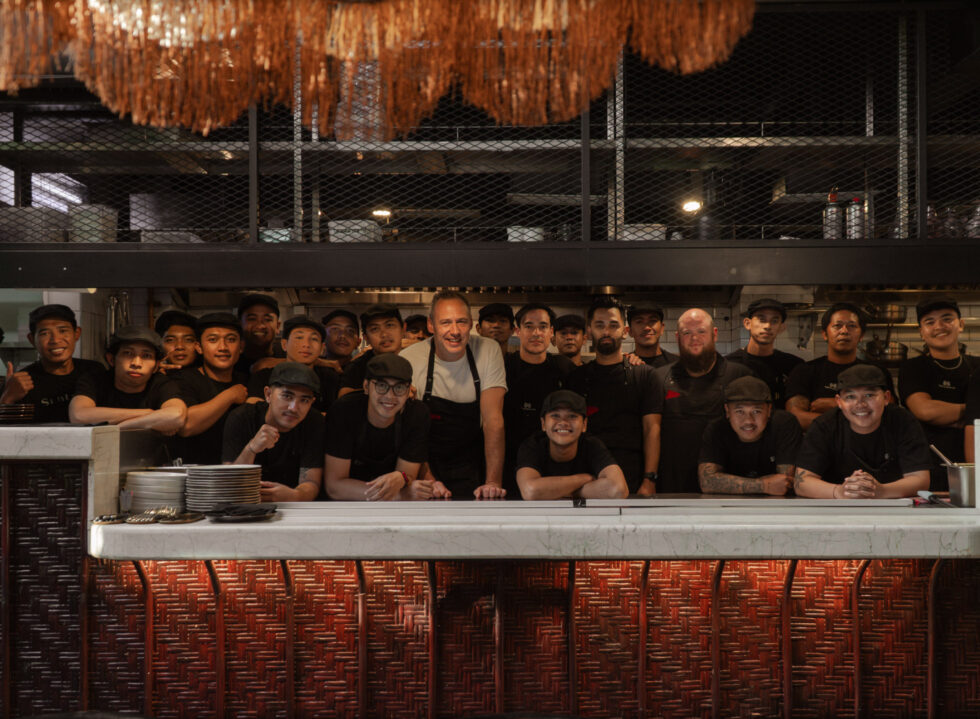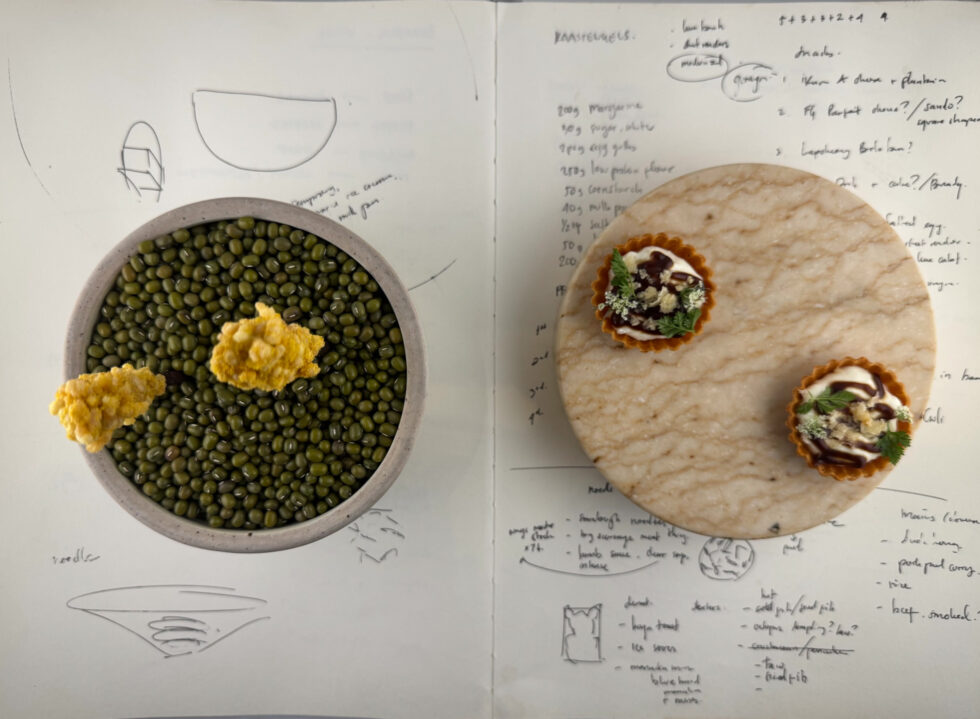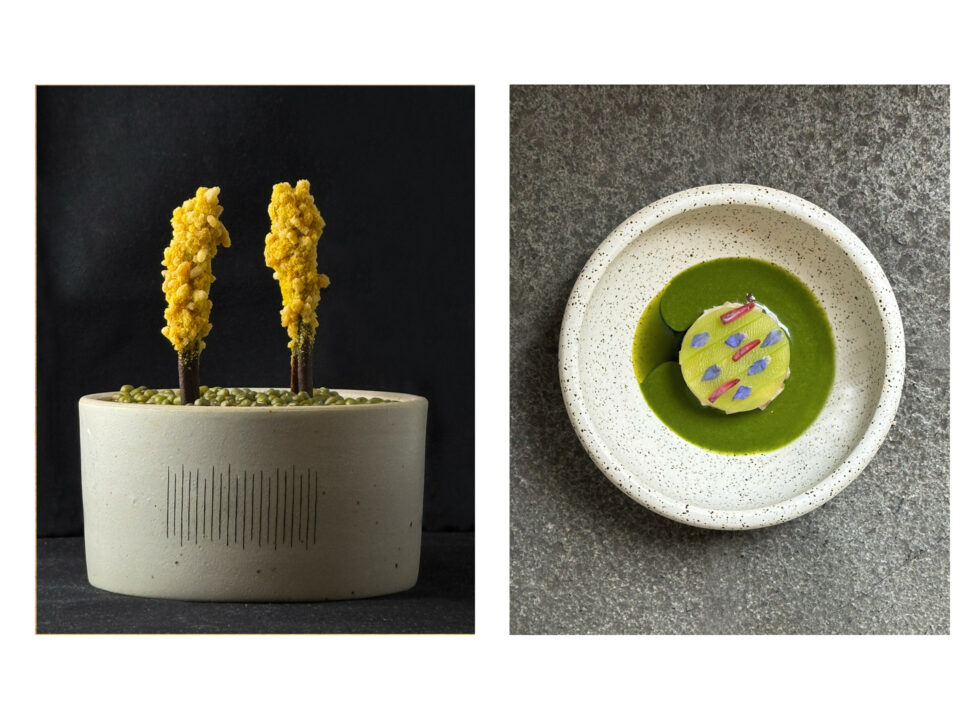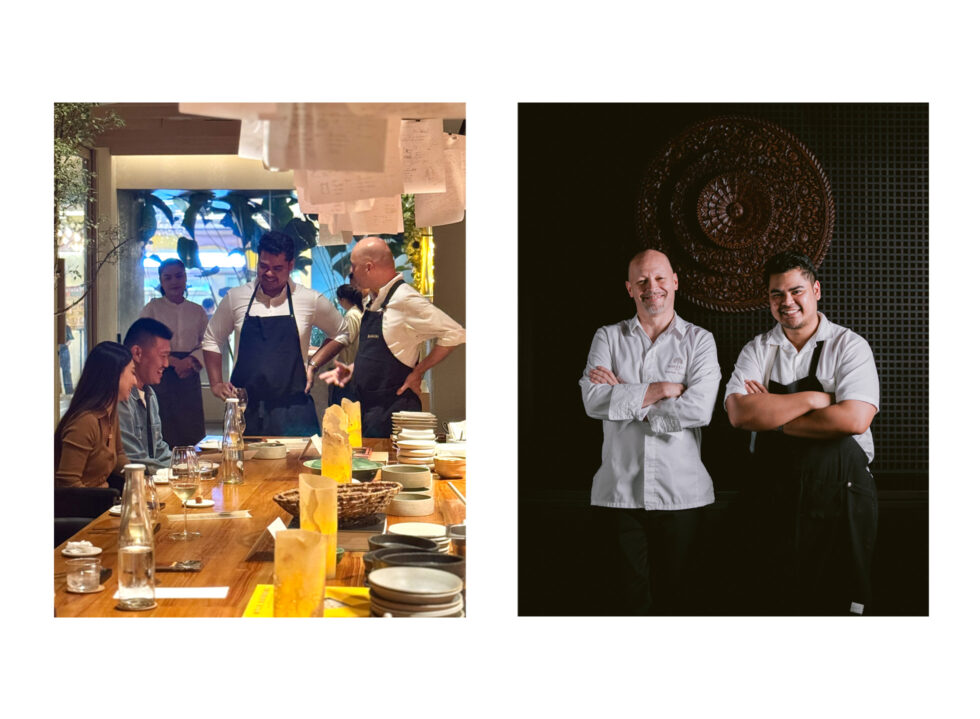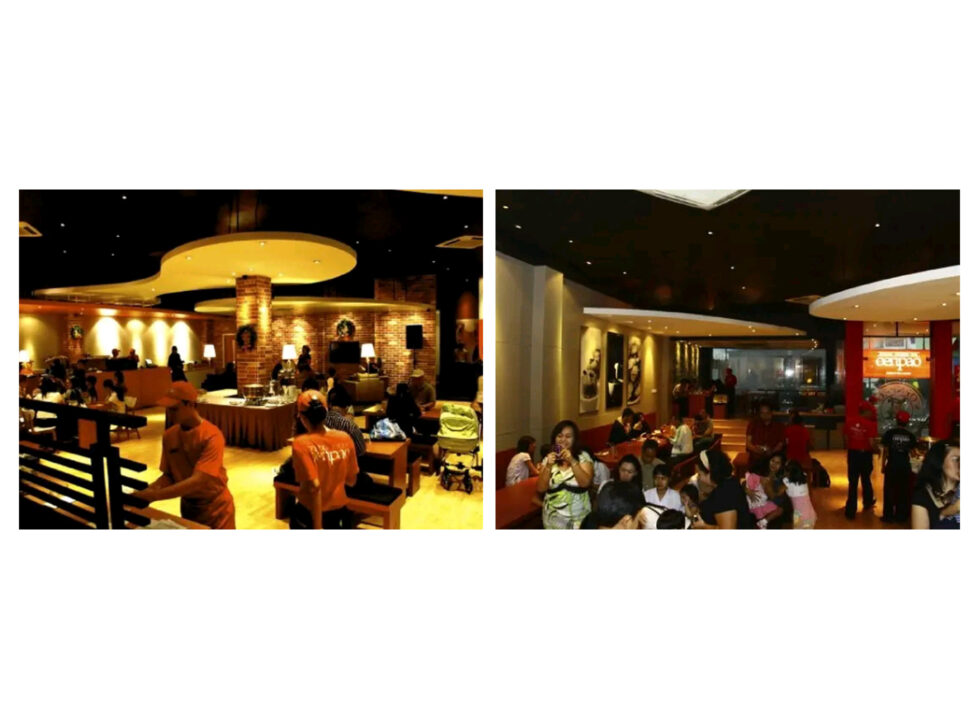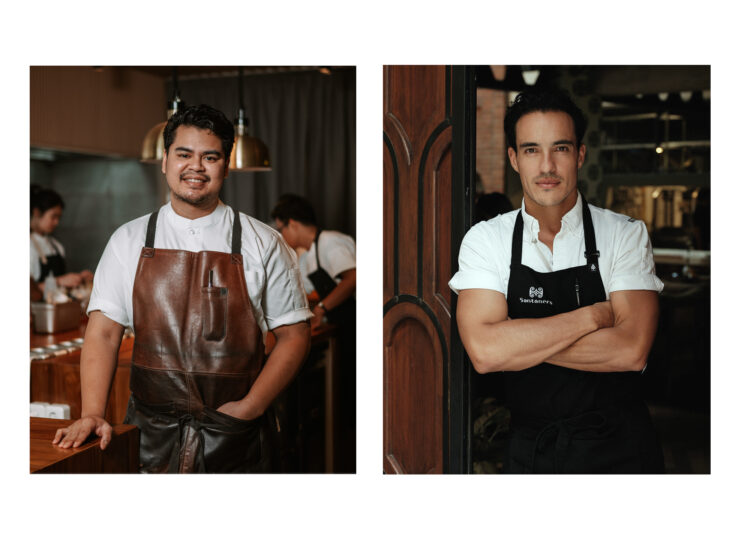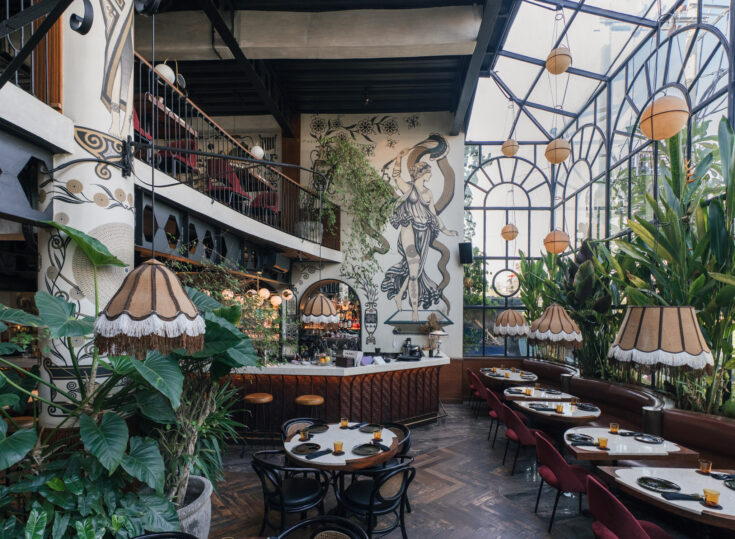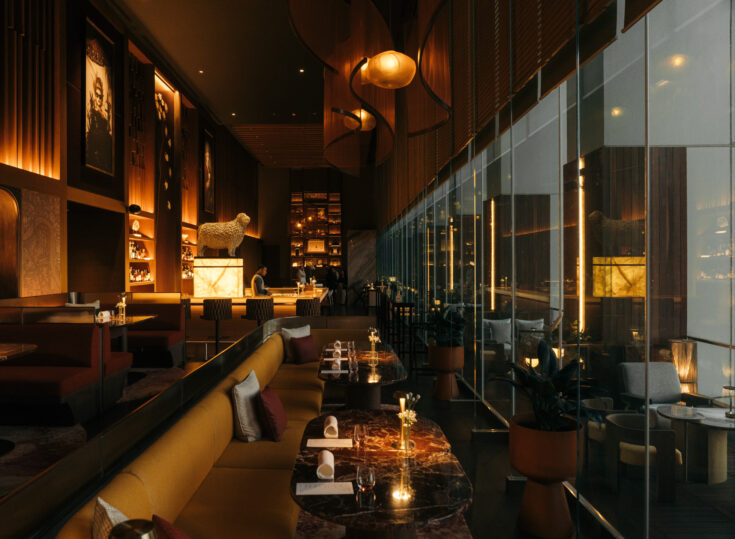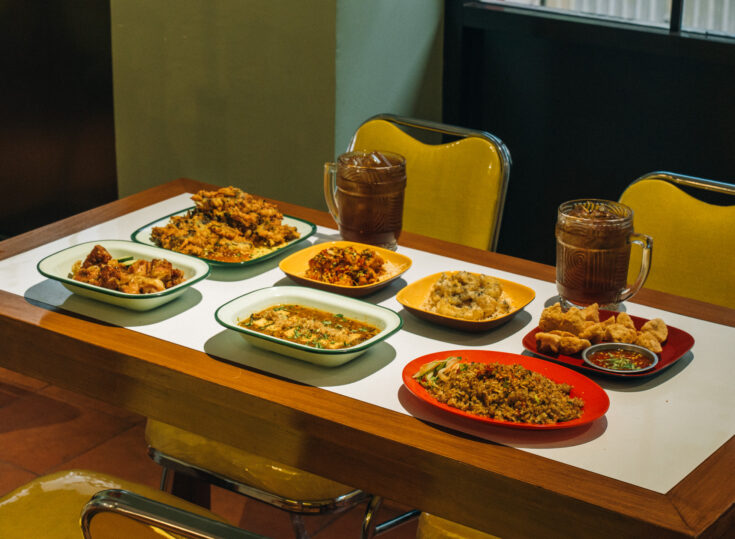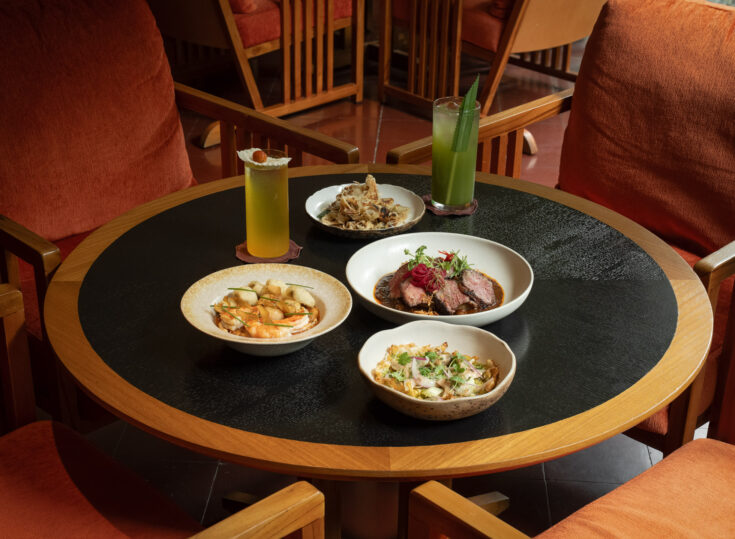Childhood for both Andrés Becerra and Aditya Muskita unfolded in the bustle of family dining rooms, where lessons of hospitality were learned firsthand. In Colombia and Jakarta, respectively, they grew up helping in their parents’ restaurants—absorbing the long hours, discipline of service, and the quiet joy of watching food bring people together.
Both chefs eventually left home to train abroad, honing their craft in some of the world’s most rigorous kitchens. Andres left Colombia at 18, working in Melbourne, Spain, and Denmark before settling in Bali, where he co-founded Santanera, a lively Latin American–Spanish restaurant shaped by local produce and global perspective.
Aditya trained in Singapore, Paris, Bali, and Copenhagen before returning to Jakarta to open ESA, a restaurant that threads Indonesian flavours within an explorative, contemporary context. Along the way, both worked under Christian Puglisi at Relae in Copenhagen, an experience that would profoundly influence their approach to running their own kitchens.
Ahead of their upcoming kitchen collaboration for Santanera’s anniversary this month, the two chefs reflect on their shared beginnings in family-run restaurants, how travel continues to inform their cooking style, and the importance of guiding the next generation of chefs.
This conversation has been condensed and edited for clarity.
Aditya Muskita (AM): Hi, Andres!
Andrés Becerra (AB): Hi, Adit! It’s a pleasure to be able to chat with you and share some of the insights of my career in this exchange.
To start off, I’m originally from Colombia. I was pretty much born in the restaurant industry. My father is a chef, and he still runs a restaurant back home where I spent a lot of my years growing up. Naturally, hospitality has been a big part of my life. That’s the first time that I realised and understood how much effort and work go into satisfying other people at a restaurant. I think that’s where my passion for this industry and for cooking, specifically, began. How about you?
AM: I was born and raised in Jakarta, but my family background is very diverse. My mother is of Chinese heritage from Bandung, while my father is from Ambon, also known as the Spice Islands in Eastern Indonesia. Growing up, we celebrated both Muslim and Christian festivities, which meant food was always central in our household.
My first real kitchen experience came through my parents’ Chinese restaurant, which started humbly in a Jakarta wet market around 2004. Before school, my brother and I would help prepare seasonings, fold dim sum, and sell chicken porridge for just IDR 5,000 a bowl. Over time, that stall grew into a much larger restaurant. My parents hoped I’d continue the family business, and while that led me to cooking school, my path eventually took a different turn.
AB: It’s interesting that you mentioned how our families may have expected us to carry on the business and continue the legacy, yet somewhere along the way, we chose a different path.
When I was about 15 or 16, I told my dad I wanted to be a chef. He warned me about how tough kitchen work is, so he put me to work in his restaurant to see for myself. I said I wanted to carry on his legacy, and he told me, ‘If you’re serious, you need to train overseas and then come back.’ But the problem was that I did go overseas, but I never went back [to Colombia], right? (laughs)
AM: My mother told me the same thing when I went to cooking school—she warned me about the long hours and how hard it is working in the kitchen. At 17 or 18, I thought I could handle it. But my first experience working in a proper kitchen was a total shock.
AB: Yeah, one thing I really learned from my dad is just how much work it takes to run a restaurant. It’s inspiring to see how much your family shaped your path from the very start.
“As chefs, we need to stay curious. Experiencing new places exposes you to diverse cuisines and perspectives, which you can then bring back to your own cooking.” – Andrés Beccera
AM: Likewise, man. It’s great to see someone with a similar background—growing up in a family business, then having the creativity to make their own restaurant. You were also previously at Relæ, right?
AB: Yeah, I was at Relæ, and that’s what I wanted to ask you: What was it like starting out in your family’s business in Indonesia, then moving overseas? It’s a different country, different culture, different pace. And Relæ wasn’t your first experience abroad, was it?
AM: I studied in Singapore and had the chance to work with Daniel Boulud. At the time, everyone said you needed to master French cuisine, and he was one of the best.
After graduating, I did some casual work in Paris before moving to New York, and saw how gruelling the kitchen could be. Then I moved to Bali, starting at Mozaic and later at Room4Dessert. Meeting Will [Goldfarb] was a big turning point; he introduced me to a higher level of fine dining and got me to set my sights on Copenhagen and Relæ.
At 22 or 23, I felt like a big shot, having worked in those kitchens and travelled the world. I emailed Jonathan, then head chef at Relæ, and he invited me to join. But that first week was rough. I’d never experienced a kitchen moving that fast, and nothing I had done before truly prepared me for the pace.
AB: Yeah, I remember showing up at 2 PM when the farm delivery arrived, and everyone was rushing to start prep for dinner. With 60–70 covers booked, it felt crazy to begin [prep] that late; it was an incredibly fast-paced kitchen.
AM: Yeah, it was insanely fast. It was amazing to work alongside those guys, many of whom had come from places like AOC, Noma, or Amass. I’d never seen that kind of speed before, and I struggled at first. But eventually I realised it was simply about trying to make good food. You know, I remember there’s a poster in the corner, right next to the pastry section. What was it?
AB: “Move fast…”
AM: “And get shit done.”
AB: Every time I looked at it, it reminded me to just keep pushing forward. My experience was similar; leaving Colombia at 18, I knew I wanted to be a chef, so I moved to Melbourne to learn and immerse myself in different cultures.
Coming from a country that isn’t very multicultural, I was amazed by the diversity. For example, you’d walk into a Thai restaurant and have an actual Thai chef cooking. There, I worked in various kitchens, but it was at MoVida, a Spanish restaurant that was one of the hottest spots at the time, that I truly discovered what a structured kitchen looked like.
AM: I love MoVida. I think they opened up in Bali one time. The food is amazing!
AB: Yeah, they tried opening at Potato Head, but it didn’t really take off.
Anyways, I was really interested in Spanish food because back then, when you thought about being on the top, you thought about places like El Buli, Mugaritz, and all these restaurants that were dictating the food scene around the world. I worked at MoVida while studying, starting as a kitchen hand, basically washing dishes. Eventually, they offered me a role at their new venue, MoVida Aquí, which is now their largest restaurant in Melbourne.
Those early days taught me discipline, consistency, and how to push myself to improve in every way. After some time there, I moved to El Casals in Spain, a family-run Michelin-starred restaurant. I wanted to go there because they have their own farm and produce their own goods, like sobrasadas (raw, cured pork sausage). That’s where I got really exposed to working in the garden, collecting ingredients and experimenting with the best techniques.
AM: You’ve been all around the world, huh?
AB: I mean, same as you, really (laughs). I think that’s one of the beautiful things about being a chef, it gives you the chance to travel the world. As chefs, we need to stay curious and experiencing new places exposes you to diverse cuisines and perspectives, which you can then bring back to your own cooking. For me, that exposure has been invaluable. How about you?
AM: I feel the same way, [travelling] it’s been hugely influential for me. Interestingly, I hadn’t actually planned to return to Indonesia, but one thing led to another, and I eventually started my own restaurant. The most valuable takeaway from all that travel has been perspective. You absorb so much, and it changes the way you approach your work today.
For instance, when I was at Relae, there was a guy named Pablo who loved bakso (meatballs). He tried cooking Indonesian dishes for staff meals, but he gave them a Spanish twist, almost like a curry, creating something entirely new. I thought, why not view Indonesian cuisine through that lens and reimagine it? So it’s about bringing what you’ve learned back home, experimenting, and finding ways to challenge the familiar.
AB: That sounds fantastic. I could definitely see that in your cooking when I had the chance to sit down at ESA. Actually, one of the reasons I went to Relae was for a symposium that René Redzepi organised. I wanted to see how leading chefs were shaping the next generation and addressing industry issues. My own training had been very old-school, with rigid structure and hierarchy, but in Copenhagen, I saw kitchens experimenting with new structures, pushing boundaries, and supporting young chefs in their growth. What’s your take on that?
AM: That’s so true. I was genuinely surprised that at Relae, by 4 or 5.30 pm, the staff had to stop everything and eat before dinner service began. In my previous experience, you didn’t stop until the work was done. I remember during those family meals, Christian [Puglisi] would talk about his three pillars of sustainability. One aspect that really stuck with me was the sustainability of manpower—it was a concept that completely shifted how I thought about running a kitchen.
It’s like you meeting all those chefs at the symposium—it felt like they were challenging the entire system. It wasn’t just about the food, but how it’s prepared, how the kitchen operates, and how the staff works and lives.
“It’s both exciting and humbling, learning how to run a business and working with new people, all while putting a piece of myself into every dish. In the end, a restaurant is a reflection of who you are.” – Aditya Muskita
AB: I’ve realised that although pushing boundaries is important, it has to be done sustainably. It’s a careful balance, challenging yourself and the team to grow while ensuring their well-being remains a priority.
AM: With all these experiences and the different perspectives you’ve gained from your travels, what was it like making the leap from a chef to being a chef-owner at Santanera?
AB: After working in Melbourne, I felt the need to step out of my comfort zone. I considered moving back to Europe, but then the pandemic happened. It was then that the opportunity to open something in Bali came up, so I decided to take the leap and put my energy into Santanera.
It was challenging on so many levels: moving countries, adapting to a new culture, and opening a business at the same time. As a chef, you’re used to focusing on craft and creativity, but as an owner, you suddenly have to manage everything. Having never worked in Indonesia before, I had to start fresh and learn to work with local produce and build relationships from scratch. It’s been one of my biggest challenges, but also one of the most rewarding journeys personally.
AM: Likewise here. Growing up in a family restaurant business, I thought I understood how things worked. But opening my own place showed me it’s a whole different world—you’re running a full business. I remember Will once told me, “When you open your own restaurant, that’s when the real work begins,” and it couldn’t be more true.
In Bali, I’d experienced how amazing and accessible the ingredients are there. Jakarta, on the other hand, is a much bigger challenge; produce isn’t as easy to source, so we often have to bring it in from other regions just to get the best quality. Rebuilding those supplier relationships from scratch while opening a restaurant was tough.
Then from day one, it becomes deeply personal. It’s my first restaurant, feels like ten-plus years of experience poured into one space. It’s both exciting and humbling, learning how to run a business and working with new people, all while putting a piece of myself into every dish. In the end, a restaurant is a reflection of who you are. It’s how we tell our story through food, and I hope every young chef has the chance to experience that.
AB: Yeah, I echo that. The restaurant reflects all your experiences, from the food to the style of dining to the service. For me, it’s how I like to eat and cook, shaped by years of cooking, travelling, and being exposed to different cuisines, taking bits and pieces from there, and bringing them together in one place. How do you think your cooking style and creative approach have evolved over the years?
AM: Wow, great question. My cooking style changed drastically when I opened ESA. I was never trained in Indonesian food, but I always wanted to approach it differently.
After culinary school, my style was very French—fine dining, Nouvelle Cuisine—until I discovered Noma and was inspired by their focus on ingredients. In Copenhagen, I learned that simplicity can be powerful. Later, working in Jakarta, I felt something was missing, so I began experimenting with Indonesian flavours.
That evolved into a style rooted in my childhood—bringing forward dishes and stories rarely seen in restaurants, reimagined through a modern lens. Instead of constantly looking abroad, I began looking closer to home and found there are many stories to tell. So now, my cooking is about storytelling and giving simple ingredients with deeper meaning. How about you—how did your style evolve into what you’re doing now at Santanera?
AB: Santanera is rooted in Latin American cuisine with a Spanish influence. I’m from Colombia, but I also spent years cooking in Spanish restaurants and fell in love with the cuisine and culture. Over time, I realised I needed to honour my roots while embracing the influences that inspired me, so Santanera brings those two worlds together.
The dining style follows the Spanish tradition, from aperitivos, tapas, and larger dishes to share, while the flavours draw on Latin America. Being in Indonesia, it’s also important for us to showcase local ingredients and the work of farmers here in Bali and beyond.
AM: That’s cool. I think Jakarta is very different from Bali. In Bali, you meet people from all over the world, which is exciting but also challenging, as you’re catering to diverse palates. Jakarta, on the other hand, feels more settled; many customers are regular faces. The upside is that you can build long-term relationships and watch people grow with you, which is heartwarming. The market in Jakarta is more particular: people are open to trying new things, but not too extreme.
“Back in the day, it was all about competition, but now I see chefs in Jakarta are collaborating, pushing boundaries, and bringing something new to the table.” – Andrés Beccera
AB: I’ve been really impressed with how Jakarta’s dining scene is evolving. Many young chefs, like yourself, Ryan Thejasukmana of Costa and Valian Gunawan of Kindling, have trained overseas and returned home, shaping a new wave of restaurants and bars. It’s fantastic to see such talent driving the city’s culinary scene forward.
AM: What’s really fun is that many of us are around the same age and opening our own restaurants at the same time, which has helped build a sense of community. We hang out, visit each other’s restaurants, and support one another.
AB: It’s fantastic to see the community you’ve built. Back in the day, it was all about competition, but now I see chefs in Jakarta are collaborating, pushing boundaries, and bringing something new to the table. I see a very bright future for Jakarta’s and Indonesia’s restaurant scene as a whole.
One thing I’ve noticed since moving here is the similarity between Indonesian and Latin American cuisine. Both being near the equator means we share a lot of the same produce. Staples like rice and coconut are important in both cultures, and even dishes like rendang have parallels in Colombia, such as estofado.
AM: I remember back in 2011 or 2012, a chef friend gave me “D.O.M: Rediscovering Brazilian Ingredients” cookbook. Reading it, we were amazed—D.O.M felt like the best restaurant in the world. I noticed they used cassava and other ingredients similar to ours. I thought, “Wow, I should travel to South America”.
I also wanted to go back to the point we mentioned earlier about building a strong kitchen team. I’ve seen many young chefs working and collaborating with you. How do you view them? Do they remind you of yourself a few years back, and what do you think about them sharing their experiences and cooking alongside you?
AB: Mentoring is one of the most rewarding parts of being a chef. Helping someone see their potential, grow their skills, and develop within a team is incredibly fulfilling. In Bali, I’ve had the chance to work with young chefs and watch them progress. The goal is to shape them into great chefs, and eventually, I hope they challenge themselves further, whether by opening their own restaurant or travelling the world. Being part of that journey is something I’m very proud of.
AM: That’s true. The greatest pride as a chef is seeing your team succeed, opening their own restaurants or building on what they’ve learned from you. At ESA, I tell the team that working here isn’t just about cooking; I teach them how to run a restaurant. From managing a kitchen to handling finances, I share everything openly so they can be successful, even more successful than I am.
AB: Yeah, I couldn’t agree more with you. It’s a responsibility in a way. So what upcoming projects do you have lined up?
AM: Right now, we’re focused on running ESA, but we’re also exploring new concepts and keeping an eye on Jakarta’s trend-driven market. The goal is to evolve the brand, improve the restaurant, and nurture new talent. We might open additional restaurants in the future, but for now, it’s about refining what we do here. How about you?
AB: We’ve been considering Jakarta to see how people resonate with our brand and food, but nothing has been decided yet. After nearly four years, Santanera is more established, and we now have systems in place to explore new projects and concepts. We’re open to opportunities, whether in Bali or Jakarta, but are still evaluating our next steps.
AM: Well, I couldn’t be happier to have you in Jakarta for sure. I mean, it’s going to be very interesting.
AB: I’m also excited to have you join us in Bali for our fourth anniversary [in November]. We’re organising a set-menu event highlighting local produce, collaborating with John Becker from Jono’s Bali, Rama Dayapati from Island Organic, and of course, yourself. Can’t wait to work alongside all of you.
AM: Looking forward as well! We’re honoured to be invited and excited to work alongside you, Rama, and John. I’ve known them for years, so it’ll be a fun and rewarding experience for Santanera. Thank you!
AB: It’s our pleasure to have you.
AM: See you soon!
